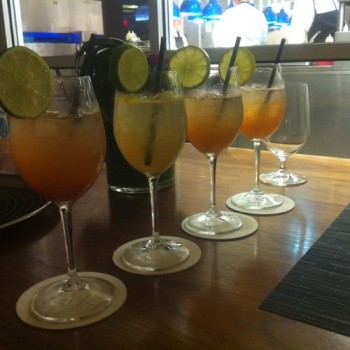Gin and tonic might be long-time BFFs (possibly involved in a torrid love triangle with vermouth) but sometimes it seems like tonic water just isn’t holding up its side of the relationship. While the mixer fills more than half of your glass, what is it really bringing to the party besides bubbles and a mild anti-malarial?
Enter Pedro Goncalves, beverage director at the Michelin-starred Oceana Restaurant in New York City, who’s joining the ranks of bartenders making their own tonics in-house. Looks like ol’ gin and tonic might still have some new adventures ahead of them after all.

Brendan Francis Newnam: So summer is gin and tonic season, right?
Pedro Goncalves: Now wait a minute, gin and tonic season is all year round, man. There’s no one season.
Brendan Francis Newnam: Really? If it was snowing outside you would come in and have an ice-cold gin and tonic?
Pedro Goncalves: Yeah, of course.
Brendan Francis Newnam: Alright, so where does tonic come from anyway?
Pedro Goncalves: Tonic is basically quinine. Quinine comes from a tree, probably originated in Peru, it’s called the cinchona tree and the quinine itself comes from the cinchona bark. The native South American Indians used to chew on this bark or make a tea with it after a hard day of hunting or agricultural activity.
Basically it’s a muscle relaxant. It helps accelerate the recovery process of the muscles so that you can relax, get a good night’s sleep and refresh in the morning.
Brendan Francis Newnam: So you’re saying after Gatorade and workouts I should turn to gin and tonics. Is that what you’re suggesting professionally?

Pedro Goncalves: Oh, definitely, absolutely. You know, gin and tonic came about a long time ago. I believe it was Thomas Cook that went down to Peru at some point in history when England was colonizing a lot of different areas, specifically India and he found that the Native Americans down there were not getting malaria.
He wondered, “why the hell are these people not getting malaria?” It turns out quinine is not just good as a muscle relaxant, it’s a preventative measure for malaria. You don’t get malaria and then this kind of prevents it and cures it.
Brendan Francis Newnam: So it’s like a shield.
Pedro Goncalves: Exactly, so he thinks, “well a lot of the English soldiers back in India are getting malaria and dying left and right, what do we do?”
So he takes quinine back to India and tells the soldiers, “Hey you guys, you should drink this. It prevents malaria, and you don’t want to die do you?” They try it and they think it’s foul, it’s terrible. So, next step is “how the hell do we get them to have quinine,” you know?
Brendan Francis Newnam: How are we going to get Navy guys to ingest quinine?
Pedro Goncalves: That’s the whole Navy strength and the whole deal. Plymouth was the first gin, I believe, to be used for gin and tonic.
Brendan Francis Newnam: So that’s what they did, they paired it with gin?
Pedro Goncalves: Yeah, man. They rationed it; I believe it was a pint a day of gin to these soldiers. You know that whole ‘Dutch courage’ thing? That’s where that came from.
Brendan Francis Newnam: And the rest is history, and now gin and tonics are part of the British identity as much as tea and the Queen.
Pedro Goncalves: For sure.
Brendan Francis Newnam: So, I’m looking at your tonics now; they’re beautiful. The first thing you notice is that there’s color in them. They look like different shades of tea. Where is that color coming from? Is it coming from that powder?
Pedro Goncalves: Indeed it is. It doesn’t just come from the cinchona bark, which is kind of a brown, a light brown color. There’s also little bits of clove and cinnamon and bay leaf and cardamom, different kinds of citrus and lemongrass and ginger and all those kinds of things. There’s a lot of things in there that actually really accentuate the botanicals in the tonic.
Brendan Francis Newnam: So, how do you go about making a tonic water? You’re basically putting all these ingredients in and infusing it.
Pedro Goncalves: You get a couple of coffee filters and put your cinchona bark powder in there with whatever ingredients you want. You put that in the coffee filter, tie the coffee filter, essentially make a tea bag.
Then you boil it under a low flame, and what this does is it extracts flavor and color. Basically, once that’s done you let it cool down, refrigerate it and once that’s all cleared away, just add a couple ounces to a glass, club soda, ice, lemon juice or lime juice and you’re done.
Brendan Francis Newnam: So basically what makes a tonic a tonic is the quinine and after that you can pretty much add anything you want.
Pedro Goncalves: Well, that’s why I have four different kinds. The bitter has no sugar whatsoever.
Brendan Francis Newnam: So maybe let’s start with that one. Can I taste it now?
Pedro Goncalves: Yeah, go ahead man. Be my guest.
Brendan Francis Newnam: I almost taste notes of nutmeg or cinnamon.
Pedro Goncalves: Absolutely. Clove will come by, the ginger usually comes out, the cinnamon as well kind of comes across and then all the citrusy kind of notes come across as well.
Brendan Francis Newnam: Alright, so I’m going to jump right ahead to the spicy tonic.
Pedro Goncalves: It’s got a little kick to it. I recommend that you take a small sip at a time
Brendan Francis Newnam: Wow. There’s definitely jalapeño in there or something.
Pedro Goncalves: No jalapeño, just capsaicin.
Brendan Francis Newnam: What is that, is that a fancy word for ‘burn your mouth off pepper?’
Pedro Goncalves: No, man. It’s basically the ingredient that you find in most hot peppers.


